Ice cream industry in USA
Introduction
Ice cream, a beloved treat across the globe, holds a special place in the hearts of Americans. From traditional flavors to innovative creations, the ice cream industry in the United States is a dynamic and evolving sector. This article explores the history, current trends, market dynamics, and future prospects of the ice cream industry in the USA
History of Ice Cream in the USA

Early Beginnings icream made its debut in the United States during the colonial era. Historical records suggest that the first mention of ice cream in America was in a letter written in 1744 by a guest of Maryland Governor William Bladen. The dessert gained popularity among the elite, including notable figures such as George Washington and Thomas Jefferson, who had their own recipes for the treat.
Industrial Revolution and Mass Production

The industrial revolution marked a significant turning point for the ice cream industry. In 1843, Nancy Johnson patented the first hand-cranked ice cream freezer, revolutionizing the production process. This invention paved the way for the establishment of commercial ice cream production. By the late 19th century, advancements in refrigeration technology further boosted the industry, making ice cream more accessible to the general public.
Market Dynamics
Size and Scope
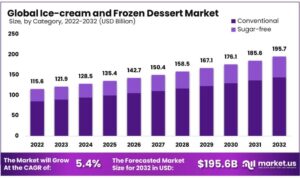
The U.S. ice cream market is vast and diverse, with a wide array of products ranging from traditional ice cream to frozen yogurt, gelato, and dairy-free alternatives. According to a report by IBISWorld, the ice cream production industry in the United States was valued at approximately $8 billion in 2021, with steady growth anticipated in the coming years.
Key Players/Fastest growing Ice cream brands
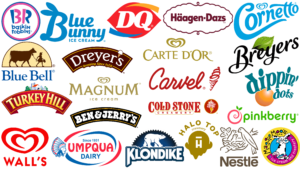
The industry is dominated by several major players and fastest growing Ice cream brands including Unilever (which owns brands like Ben & Jerry’s and Breyers), Nestlé (owner of Häagen-Dazs and Dreyer’s), and Dean Foods. These companies have established strong brand recognition and extensive distribution networks, enabling them to maintain significant market share.
Distribution Channels

Ice cream is distributed through various channels, including supermarkets, convenience stores, specialty ice cream shops, and online platforms. The rise of e-commerce has introduced a new dimension to the industry, with consumers increasingly opting for home delivery services.
Consumer Trends

Flavor Innovations
American consumers are adventurous when it comes to ice cream flavors. While classics like vanilla, chocolate, and strawberry remain popular, there is a growing demand for unique and exotic flavors. Artisanal ice cream makers are experimenting with ingredients such as lavender, matcha, and even savory components like bacon and cheese to create novel taste experiences.
Health Consciousness

As health and wellness trends continue to influence consumer choices, the ice cream industry has responded by offering healthier alternatives. Low-fat, low-sugar, and plant-based ice creams have gained traction. Brands like Halo Top have capitalized on this trend by marketing their products as guilt-free indulgences with reduced calorie counts.
Sustainability
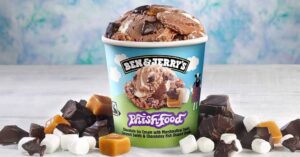
Sustainability is becoming a key consideration for both producers and consumers in the ice cream industry. Companies are increasingly adopting eco-friendly practices, such as using biodegradable packaging and sourcing ingredients from sustainable suppliers. Ben & Jerry’s, for example, is known for its commitment to environmental and social causes, which resonates with ethically-minded consumers.
Challenges Facing the Industry
Seasonal Demand
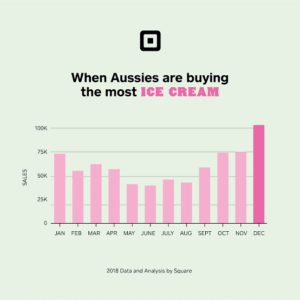
Ice cream sales are highly seasonal, with a significant spike during the summer months. This seasonality poses challenges for producers and retailers, who must manage inventory and production schedules to align with fluctuating demand.
Health Concerns
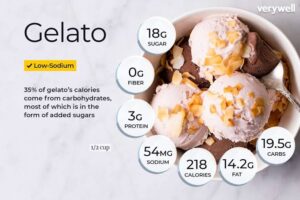
Despite the growing market for healthier ice cream options, the traditional product is often associated with high sugar and fat content. As public health campaigns continue to highlight the risks of excessive sugar consumption, the industry faces pressure to reformulate products or clearly communicate nutritional information to consumers.
Competition from Alternatives
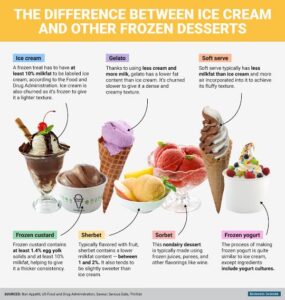
The rise of frozen desserts such as gelato, sorbet, and frozen yogurt presents stiff competition to traditional ice cream. These alternatives often market themselves as healthier or more refined options, appealing to different consumer segments and preferences.
Future Prospects
Technological Advancements

Technological innovations are set to play a crucial role in the future of the ice cream industry. Advances in food science and production techniques can lead to the creation of new textures and flavors, while improvements in refrigeration technology can enhance product quality and shelf life.
Expansion into Emerging Markets/Demographics of Ice cream consumers

While the U.S. market is mature, there is potential for growth in emerging markets.in above chart we tried to show global demographics of ice cream consumers, American ice cream brands can capitalize on the increasing disposable income and changing dietary preferences in countries such as China and India, where Western-style desserts are gaining popularity.
Customization and Personalization

Personalization is a growing trend in the food industry, and ice cream is no exception. Some companies are offering customizable ice cream experiences, allowing consumers to choose their base flavor, mix-ins, and toppings. This trend not only enhances the consumer experience but also fosters brand loyalty.
Conclusion
The ice cream industry in the USA is a dynamic and multifaceted sector, characterized by rich history, constant innovation, and evolving consumer preferences. Despite facing challenges such as health concerns and seasonal demand, the industry continues to thrive by adapting to market trends and embracing new opportunities. As technology advances and sustainability becomes increasingly important, the future of ice cream in the United States looks promising, with endless possibilities for growth and innovation.
References
1. IBISWorld. (2021). Ice Cream Production in the US – Market Research Report.
2. Mintel. (2022). Ice Cream and Frozen Novelties Market Report.
3. Statista. (2022). Ice Cream Industry in the US – Statistics & Facts.
4. Unilever Annual Report. (2021).
5. Nestlé Annual Report. (2021).
6. USDA Economic Research Service. (2022). Dairy Data.
7. National Dairy Council. (2021). The History of Ice Cream.
8. American Dairy Association. (2021). Trends in the Ice Cream Industry.
—
This article provides a comprehensive overview of the ice cream industry in the USA, exploring its history, market dynamics, consumer trends, challenges, and future prospects. The structure ensures a logical flow, making it easy for readers to understand the various aspects of the industry. If you have any specific points or sections you’d like to expand further, please let me know!


